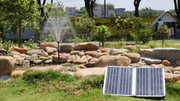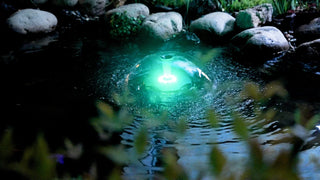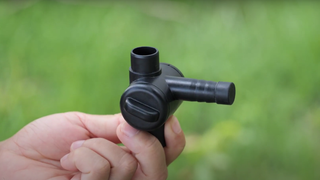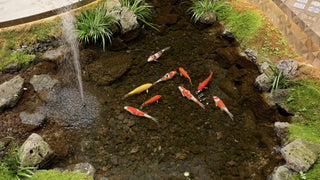
The allure of a sun-driven water feature is easy to understand: sparkling spray, zero electric bill, and a gentle hum that draws birds and butterflies. But sooner or later every pond keeper asks the same question: will my solar fountain still perform when the weather turns gray? Below is an in-depth look at how Poposoap solar pumps behave under clouds, what our field research uncovered, and the simple tweaks that guarantee dependable pond solar reliability even in less-than-perfect light.
How Solar Pumps Work
A Poposoap solar fountain is a miniature power plant built around four core parts:
- Photovoltaic panel – high-efficiency mono-crystalline cells convert sunlight into direct-current electricity.
- Controller – smooths voltage, diverts surplus to an optional lithium battery, and prevents low-voltage stutter.
- Brushless DC pump – a magnetic impeller transforms that electricity into flow and head height.
- Nozzle or aerator head – shapes the water into bells, umbrellas, geysers, or frothy oxygen plumes.
Because there’s no AC inversion, energy loss stays minimal—but output tracks sunlight almost one-to-one. Bright sky, strong fountain; heavy cloud, reduced flow … unless a battery steps in.
Impact of Weather on Performance
Under clear noon sun (≈1000 W m⁻²), a 10-watt Poposoap Solar Fountain lifts water 70–80 cm and pushes around 120 gph. Light overcast (≈600 W m⁻²) trims those numbers to roughly 50 cm and 80 gph. Dense cloud (≈250 W m⁻²) can leave a direct-drive unit dribbling—or pausing entirely—unless it taps stored energy. The physics is simple: fewer photons, fewer electrons, slower impeller.
Field Test Sharing—Three Pumps, Two Weeks, One Cloudy Autumn

To see how theory meets reality, we installed three Poposoap models side-by-side on a 300-gallon pond for fourteen consecutive days of mixed sun and drizzle in the mid-Atlantic:
- Compact Fountain (6 W panel, no battery) fitted with a four-tier geyser nozzle.
- Everyday Fountain (12 W panel, 2200 mAh battery) running a bell-umbrella head.
- Performance Fountain (25 W panel, 4400 mAh battery) set up with a high column “volcano” jet.
A pyranometer logged solar irradiance every 15 seconds while we recorded flow height and duration.
Morning haze (≈350 W m⁻²)
- Compact produced intermittent spurts, restarting every eight seconds.
- Everyday maintained a steady 35 cm bell; battery remained idle.
- Performance surged at full strength, charging its battery simultaneously.
Mid-afternoon clearing (≈650 W m⁻²)
All three fountains achieved roughly 80 % of their full specs, and both battery units topped off within twenty minutes.
Thunderstorm front (irradiance dipped to 180 W m⁻²)
- Compact stopped within 90 seconds and stayed off until light rose above 250 W m⁻².
- Everyday switched to battery, delivering half-height flow for just over two hours before an automatic low-voltage shut-down protected the cells.
- Performance alternated forty seconds on, twenty off, for nearly four hours thanks to its larger reserve.
Overall takeaway: a direct-drive pump will pause under dense cloud, but a modest lithium pack can keep aeration alive through most gray spells, proving the value of a well-matched storage module for anyone seeking rock-solid solar fountain cloudy days performance.
Cloudy-Day Optimization Tips
- Angle for winter light. Tilt panels to your latitude’s winter-solstice angle; diffuse radiation then strikes more squarely.
- Keep panels spotless. Dust and pollen can rob you of 10–15 %—exactly the margin needed in overcast weather.
- Choose low-head nozzles. Umbrella or bell styles demand less pressure, so they remain lively when voltage dips.
- Add a battery. Snap-in Poposoap battery backups (1800–5200 mAh) install in seconds and supply one to four hours of reserve flow.
- Split the workload. Let your main fountain run on the sun; pair it with a tiny Poposoap pond aerator on a separate panel to guarantee oxygen during nighttime or storms.
Follow these steps and your solar pump test results will mirror ours—dependable lifts even in variable skies.
Poposoap Design Highlights

- Smart-chip controllers soften start-ups and prevent the rapid cycling that destroys cheaper pumps.
- Oversize cables (5 m) let you chase the brightest patch of sky without moving the basin.
- True plug-and-play batteries slide between panel and pump—no wiring, no polarity guesswork.
- High-torque impellers hold pressure when voltage sags, squeezing more lift from every photon.
- Weather-proof ABS housings shrug off drizzle and UV alike, extending service life well beyond budget models.
Matched with waterfall kits for surface agitation or multi-color pond lights for evening ambiance, Poposoap’s gear turns fickle sunlight into reliable motion and oxygen—day after day, cloud after cloud.
Conclusion: Reliability Is Engineered, Not Imagined
So, do solar fountains function on overcast days? You bet—when they're backed by intelligent electronics, effective panels, and properly sized batteries. Poposoap's field-tested range demonstrates that a well-considered solar installation can protect fish, move nutrients, and maintain that calming burble, even when the weather refuses to look up. Pay once, tilt your panel, wash it clean, and you'll have steadfast water movement while the grid remains dormant.










